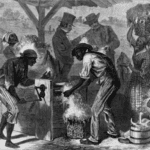Delphine Lalaurie, the “Savage Mistress” of New Orleans, hid a gruesome reality behind her socialite façade: a torture chamber where enslaved people suffered unimaginable horrors. The 1834 fire at the LaLaurie Mansion exposed not only the sadistic acts of Madame Lalaurie but also the complicity of New Orleans society in the face of slavery’s brutality. Whispers of Madame LaLaurie’s cruelty circulated long before the fire, revealing a chilling truth: justice for enslaved people was often impossible to find in antebellum New Orleans. Despite her horrific crimes, Delphine LaLaurie’s fate remains shrouded in mystery, with conflicting accounts surrounding her death and final resting place.
Early Life & Marriages
Born on March 19, 1787, into a prominent, wealthy, slave-owning family in New Orleans, Spanish Louisiana, Delphine Macarty Lalaurie seemed destined for a life of privilege. Her family’s wealth and status afforded her a position within the upper echelons of New Orleans society. She navigated this world with grace, further solidifying her standing through three marriages, each to a man of significant social prominence:
- 1800: Don Ramón de Lopez y Angulo (Spanish Royal Officer) – Died in 1804.
- 1808: Jean Blanque (Banker, Merchant, Lawyer) – Died in 1816.
- 1825: Dr. Leonard Louis Nicolas LaLaurie (Physician, much younger)
It was during her third marriage, after she acquired the property at 1140 Royal Street in 1831, that Delphine’s outward charm began to crumble, revealing a much darker nature.
The LaLaurie Mansion and Escalating Cruelty
The mansion at 1140 Royal Street, now infamous as the LaLaurie Mansion, became a sinister stage for Delphine’s escalating cruelty. Between 1831 and 1834, accounts suggest a horrifying transformation took place. The whispers started subtly—enslaved people disappearing, cries cutting through the night. Some people claimed to have seen emaciated figures bearing the scars of whippings and brandings. Yet, these whispers were often silenced, dismissed as mere gossip by a society all too willing to turn a blind eye to the realities of slavery.
The 1834 Fire and Discovery
On April 10, 1834, a fire erupted in the LaLaurie Mansion, forever changing the course of Delphine’s life and cementing her legacy as the “Savage Mistress.” What began as an apparent accident quickly transformed into a scene of unimaginable horror. As firefighters battled the blaze, they stumbled upon a hidden chamber, concealed behind a locked door.
Inside, they discovered a sight so horrific that it shocked even the most hardened among them. Seven enslaved people, some chained and suspended from the walls, bore the marks of torture so severe, so grotesque, that it defied human comprehension. Some were found with their limbs disjointed and crudely set back in place. Others had been subjected to horrific medical experiments, their bodies carved open and mutilated. The air was thick with the stench of blood, excrement, and decay.
Torture and Murder: Accounts and Evidence
While the specific details of the atrocities committed within the LaLaurie Mansion are debated, the consistent accounts of torture, mutilation, starvation, and murder paint a horrifying picture. Harriet Martineau, an author who visited New Orleans in 1836, documented firsthand accounts from residents, describing the horrors found in the mansion in her 1838 writings. These accounts, passed down through generations, tell a consistent story of unimaginable cruelty.
Adding to the horror, several deceased individuals were found within the mansion’s walls, their bodies bearing the undeniable marks of torture and murder. One of the most disturbing aspects of LaLaurie’s reign of terror was her alleged treatment of children, including a young enslaved girl named Lia who endured LaLaurie’s particular brand of cruelty. The most chilling story, the one that seems to linger in the air of New Orleans like a ghost, is the tale of Lalaurie chasing a young enslaved child across the rooftops of her mansion. This chase, if it did indeed happen, ended tragically with the child falling to their death. While no concrete evidence exists to fully confirm this event, its power lies in its symbolism. It speaks to a depth of depravity that is difficult to comprehend, painting a picture of Lalaurie as a figure devoid of human compassion.
Despite the undeniable evidence and the wave of public outrage that followed the fire, no formal charges were ever brought against Delphine LaLaurie for her crimes against the enslaved people in her care.
Escape, Exile, and a Shrouded End
In the chaos that ensued after the fire, Delphine LaLaurie, protected by her wealth and connections, managed to escape the mob’s wrath. Some say she fled to Alabama, while others claim she sought refuge in Paris, living out her days under an assumed identity. Whatever really happened, Madame LaLaurie’s fate remains a mystery. No official records confirm her death or whereabouts after she fled New Orleans.
Some records suggest she died in Paris in 1849. However, a purported discovery of her remains in New Orleans in 1933 casts doubt on the exact location and date of her death. It’s possible she did escape to France and lived out her days in quiet anonymity. Or maybe, just maybe, the whispers hold some truth, and she spent the rest of her life looking over her shoulder, forever marked by the shadows of her crimes.
The LaLaurie Mansion Today
The mansion at 1140 Royal Street, once a symbol of wealth and grandeur, became a haunted monument to the horrors that had transpired within its walls. To this day, it remains a source of morbid fascination, attracting tourists drawn to its grisly history. Some claim to feel a palpable sense of dread within its walls, to hear the echoes of screams carried on the wind. For fans of horror, Madame Lalaurie’s house in New Orleans is a must-see. It’s been deemed the most haunted house in America, and you can read more about its terrifying history here.
A Chilling Reminder
The story of Madame Lalaurie is not just a tale of individual cruelty. It is a chilling example of how a society can become complicit in unspeakable acts by choosing to ignore the whispers of injustice. It is a story that continues to resonate, reminding us that the darkest chapters of history should never be forgotten. The story of Madame Delphine Lalaurie continues to fascinate and horrify, her name forever entwined with the darkest chapters of New Orleans history. Her former mansion, a silent sentinel to the suffering that once unfolded within its walls, now serves as a museum. It stands as a stark and chilling reminder of the horrors of slavery and the human capacity for cruelty. The stories of Lalaurie’s victims, forever etched in the city’s memory, serve as a reminder of the importance of confronting injustice and fighting for the dignity of all.
The LaLaurie case shares a chilling parallel with the story of Mary Surratt, the only woman executed for the assassination of President Lincoln. Her last words are truly chilling, offering another glimpse into the dark side of history.
- Revolution Space: Disruptive Ion Propulsion Transforming Satellites - April 24, 2025
- Race Through Space: Fun Family Game for Kids - April 24, 2025
- Unlocking the Universe: reading about stars 6th grade Guide - April 24, 2025
















